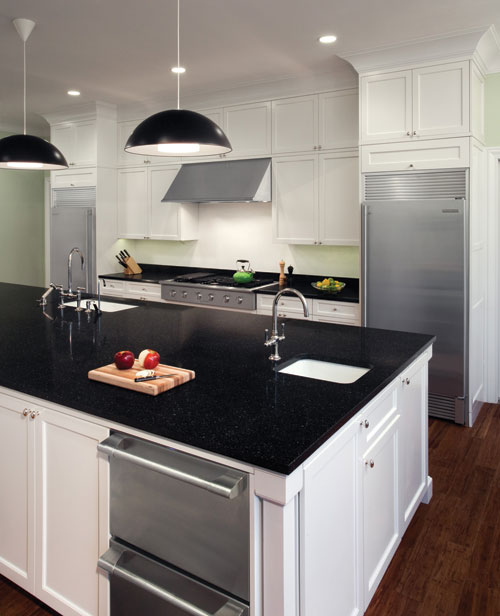Built-in Appliances: Combining Thoughtful Design Innovation with Superior Energy Performance
Induction Cook-tops and Range-tops
When considering electric cook-tops and range-tops, consider the following:
- Induction elements are the newest and most innovative types of cook-tops. The induction elements transfer electromagnetic energy directly to the pan, where heat is needed. When the pan is removed, there is almost no lingering heat on the cook-top. As a result, they are very energy efficient, using significantly less energy than other standard cooking elements. In fact, in a separate comparison of different types of cooking systems and design strategies, induction cooking was found to be 20 percent more efficient than typical radiant electric, and 70 percent more efficient than gas. This analysis looked at light-, medium-, and heavy-duty cooking usage and found essentially the same advantage of induction elements in all three cases.
 |
The U.S. EPA ENERGY STAR® program has identified typical energy uses in households. Photo courtesy of Electrolux ICON® |
Â
Cooking with induction is also more responsive than gas or electric - heat levels can be instantly adjusted from a delicate simmer or up to a quick boil. Some manufacturers have even designed in specific controls to enhance the speed of heat level changes and a variety of induction element sizes for adaptability and flexibility in cooking areas. Further, some manufacturers offer different preset touch settings on the control panel that can provide a range of preset heat levels for quick adjustments.
- Radiant electric coils by comparison, are probably the most commonly thought of electric cook-top surface, but they are known for low ratings on appearance, functionality, and energy efficiency.
- Solid disk elements are more attractive than coils and they are easier to clean. But since they heat up even more slowly than electric coils, and higher-wattage elements are generally used, energy consumption will be higher.
- Radiant elements under ceramic glass are easy to clean and heat up faster than solid disk elements, though not as quickly as conventional coil elements. The energy efficiency of ceramic glass cook-tops is higher than coil or disk element cook-tops. As with solid disk elements, flat pans are important for maximizing heat transfer from the cook-top to the pan.
- Halogen elements use halogen lamps as the heat source under a glass surface. The lamp delivers instant heat and responds very quickly to temperature setting changes. The heating efficiency of halogen units may not be better than that of ceramic glass units, and halogen elements will provide only marginally faster speed.
Ovens
When specifying ovens, there are many alternatives in terms of type of cooking method, size, energy source, and even combination of types within a single appliance. Consider the following points:
- Conventional Ovens. With standard gas or electric ovens, self-cleaning models are more energy efficient because they have more insulation. Using the self-cleaning feature more than about once a month, however, will use more energy than is saved from the extra insulation.
- Convection Ovens. These ovens can be more energy efficient than standard ovens because the heated air is continuously circulated around the food being cooked. Heat is distributed more evenly, and cooking time can be decreased. On average, convection ovens can reduce energy use by 20 percent, compared to conventional ovens.
- Microwave Ovens. Microwaves generally use one-half to two-thirds as much electricity as a conventional electric range or oven, particularly when used for reheating small portions. Because less heat is generated in the kitchen, residual savings may accrue from reduced air conditioning during the summer months.
- Warming Drawers. Smaller warming drawers installed separately from ovens can be an efficient alternative to holding food at a slightly elevated temperature without the need to use an oven. Offering flexibility and control, they also use only the amount of energy needed for warming rather than full cooking.
Since the ENERGY STAR program currently does not rate cooking appliances, specifications should not reference it as a standard for stoves, cook-tops, or ovens. Nonetheless, there are many other resources available, including those listed at the end of this article, so architects can readily find information to specify energy-efficient and environmentally responsible appliances of all types.









